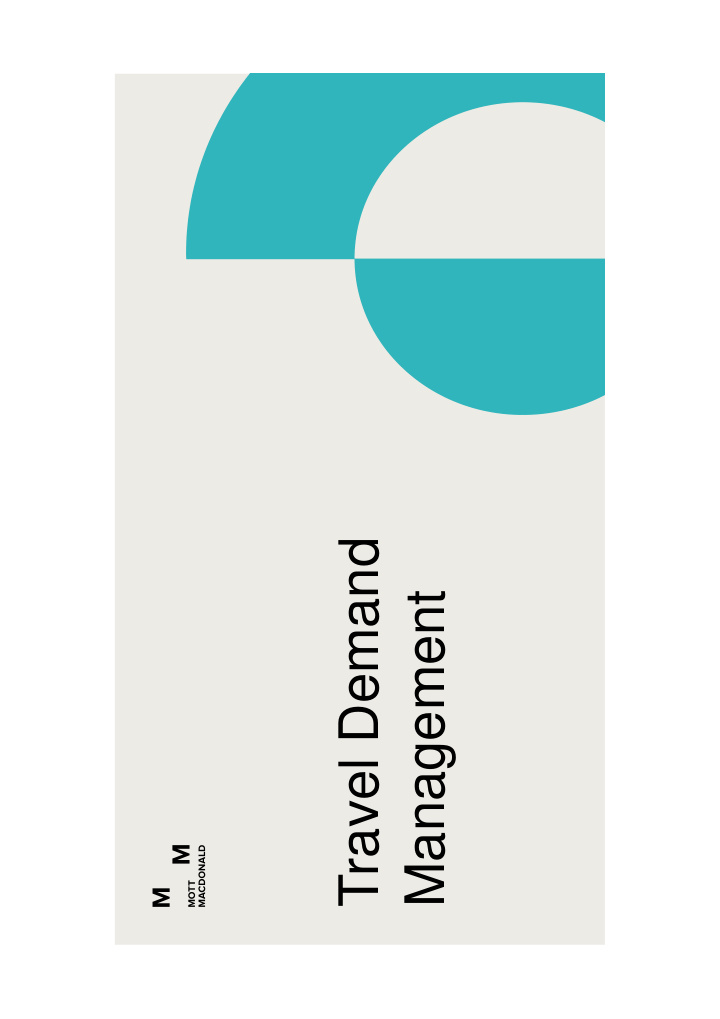



Travel Demand Management
Travel Demand Management Travel demand management balances the transport network by first understanding where there are current and forecast pressures, and then working out where there is spare capacity for these to move to. These movements are then redistributed to different modes, times, and routes with spare capacity. You need to use capacity enhancement , network managemen t, and behaviour change practices to achieve it. Behaviour change is the core area of work, we use the 4Rs principle of Retime, Reroute, Remode, Reduce 2
An effective TDM campaign can: • Manage expectation – so that reasonable passenger and business expectations are set • Manage total demand at hotspots – retime, re-mode, re-route, spread the peak • Help optimise the transport network – by providing all users with guidance on the most appropriate routes available (including non- intuitive) • Support transport reputation • Provide legacy foundations for long-term positive behavioural change 3
4
Behaviour Change Interventions & Audience Segmentation • Working with business & intermediaries Travel Advice • Sliding scale of support • Targeted self help material for CBD Organisations • Targeted areas of focus TDM Programme • Engagement with the industry • Change to delivery patterns Travel Advice for Freight • Web toolkit & Focus group • Melbourne wide awareness campaign • Business focus campaign TDM • CBD hotspots campaign Communications • Visitor hotspots campaign • Travel web pages Travel • Visitor journey planner Advice for • Real time travel information Visitors • Maps and guides and info points
There is a common approach with every program • Define the problem – it is always data led • Understand what capacity you have available • Develop your message to ensure the network is balanced and achieve sign up from stakeholders (internal and external) • Define the relevant audiences and the right communicate channels that will reach them • Deliver the message and engage with your audience to change behaviours • Feed a consistent message through these channels 7
In summary it is The right information To the right people At the right time In the right way 8
TDM in Practice
Using data to define your problem and define your message 10
Agency collaboration on message and communication 11
13
Keeping Sydney Moving Up to 15% change in journeys 20,000 vehicle to/through the trips CBD Our target for Sydney is to influence 20,000 private vehicle trips to move outside of the peak periods or to move to public transport and active travel options as well as use better routes (designated by us)
15
An approach to reaching CBD employees that drive 12,000 businesses in Sydney CBD employ approx. 360,000 people Going to just 18% of these 12,000 businesses get us a 75% capture Developing ‘hotspots’ makes this even more targeted, effective & efficient 6013 employees 5210 employees 782 vehicle drivers 990 vehicle drivers (13%) (19%) 6290 employees 692 vehicle drivers 5995 employees (11%) 839 vehicle drivers (14%) 7296 employees 803 vehicle drivers (11%) 7668 employees 8262 employees 767 vehicle drivers 1157 vehicle (10%) drivers (14%) 3785 employees 719 vehicle drivers 4315 employees (19%) 733 vehicle drivers 6726 employees (17%) 942 vehicle drivers (14%) 16
Defining and supporting a hotspot Example Case Study Darling Park: CBD business hotspot 8,262 employees 27 businesses 1,157 vehicle drivers (14%) 9 businesses have over 500 employees 17
Engaging with business Large (over 1,000 people) Size, Between 500 Site Location and and 1,000 Specific how affected people Advice Workshop Under 500 Drop In Session & printed toolkit Small Website visit & download toolkit Level of Support 18
Café Bianco Drop In Session & printed toolkit 19
Year 1Results At the end of Year Our Audience Target 1 Number of BIs engaged with the program 40 46 Number of SSAs actively engaged with 78 81 the program Number of employees reached ('the 100,000 162,000 audience') Workshop attendance (orgs) 460 498 600 businesses now part of the program
Recommend
More recommend